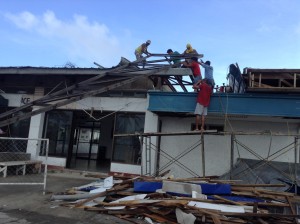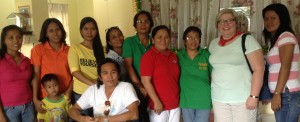
On a Monday in November, Stacy Remke responded to a call from Project HOPE for bereavement services in the wake of the Typhoon Haiyan. That Thursday, she was on a plane from Minnesota to the Philippines.
“That’s how quickly it all came up,” says Remke. “It speaks to the virtue of having a passport ready to go.”
Remke is a teaching specialist in the School of Social Work who specializes in grief and loss. She became part of an advanced planning team of three that, from November 21 through December 1, would lay the foundation for more than 300 volunteers to follow. The team helped build an infrastructure and create a setting in the Philippines to support Project HOPE volunteers in the weeks, months, and years to come.
Project HOPE provides disaster relief and ongoing support for health care by supporting the competence and durability of health services and sustainability in areas around the world that are struggling. After the powerful typhoon swept through the Philippines on November 8, Project HOPE began assembling a small team that could assess the damage and needs in the islands of Southeast Asia.

For Remke, a specialist in bereavement, it was a mission she was passionate about supporting. Bereavement is a phase of life when someone has experienced a loss—emotional, physical, psychological, or relationship shifts. In the wake of a disaster, bereavement services are necessary for community healing.
The team originally planned to travel to Tacloban, an area devastated as the typhoon swept in from the east. But upon the group’s touchdown in the Philippines, they learned their target region was paralyzed. They turned their attention to Panay, straight west of Tacloban. Two weeks after the storm, they were the first relief group to arrive in Topaz, a town in the middle of Panay island, directly in Haiyan’s path.
“Rice paddies and banana plantations had been flattened,” says Remke. “A lot of the houses, made of woven mats, were smashed.”
From grief and loss to traumatic stress
Topaz had been without power since the storm hit and didn’t expect it to return for another month. The roof of the health system had blown off, with substantial damage to the local hospital. Staff in the town had been working non-stop. Remke’s role quickly changed from addressing grief and loss to addressing traumatic stress.

“People had been pulling together and working in overdrive to meet immediate needs and figure out what they needed to do as a community,” Remke says. With little help from the local military, much of the stress fell on the shoulders of municipality workers, such as the mayor’s office, administrative staff, and social work staff.
Every day for Remke in the Philippines was centered on identifying a project for the future volunteers and meeting local people who would be able to assist in implementing it. Working in the local cultural context, Remke says, it was important for the team to meet with appropriate dignitaries as they planned.
The first dignitaries the team spoke with when they arrived were Topaz’s mayor and health department director. The mayor expressed deep concern about the Indigenous people who lived in Upland villages accessible only by footpaths, cut off by the storm. In response, the Project HOPE advisers proposed a team of doctors and nurses for triage work in the Uplands.
The team also identified temporary housing, food, and supplies for the 18-20 volunteers expected in the weeks to come.

“I like working at that macro level and bringing together systems and making connections,” says Remke.
Back in Minnesota, Remke remained involved, finishing a report, identifying needs, and recommending the most useful types of volunteers. She hopes to see future groups implementing grief and loss strategies into their relief projects.
“Social workers are well prepared to provide emotional support in the context of extreme circumstances to people in distress,” she says. And, like Remke, they are ready to jump at the opportunity to serve people in need around the world.
Read more about Stacy Remke and the School of Social Work.
Story by Ali Lacey | Photos by Stacy Remke